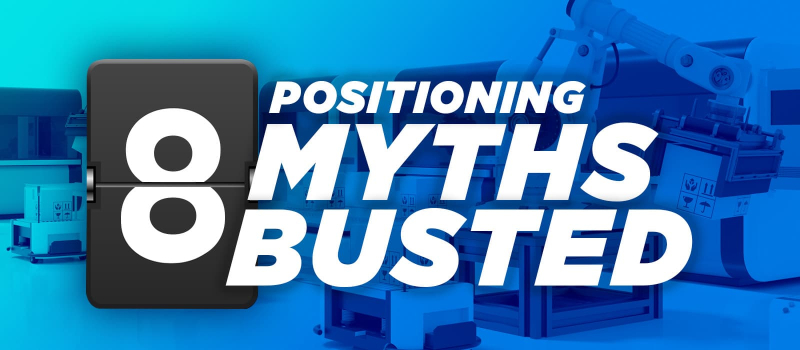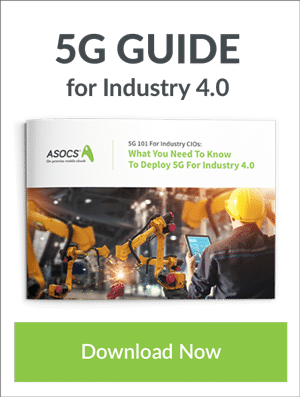
ASOCS reached a major breakthrough in May 2022 CYRUS® release – Network Slicing, its private network 5G offering can now offer both eMMB (Mobile Broadband) and URLLC (Ultra-Reliable Low Latency Communication), as a standard on a single system, based on application, device, and customer needs.
By Len Schuch, GM 5G Positioning ASOCS
Hype, Rumors & Myth-busting
There have been a number of demonstrations of location or positioning services over 5G in 2023, with varying degrees of success combined with interest from a number of different industries. The need for an indoor or campus (single network indoor and outdoor facility) use that can accurately position equipment, materials, tools, or even people are varied and obvious. Examples include tracking Autonomous Mobile Robots (AMRs) in factories or warehouses, beds in hospitals, people moving through a potentially hazardous area, or where specialized tools are.
Since launching Hermes (ASOCS’ AI-driven Positioning Service over Private 5G) PoC phase at the beginning of 2023, we have heard many misconceptions and myths. Here is a collection of some of the top ones we have come across so far. They can be divided into 2 main sections – general myths and myths ASOCS are busting. Here are the top 8.
General Myths
Myth 1: 5G Positioning needs to reach a centimeter accuracy before it is useful.
Contrary to opinions, 5G Positioning does not need to reach centimeter or deci-centimeter accuracy before companies adopt it. There is a multitude of use cases for each industrial vertical and whilst there are existing Real-Time Location Services (RTLS) technologies like Bluetooth (BLE), Wi-Fi, UWB, RFID, etc. that provide this level of accuracy, those mostly cater for corner cases for a specific task in a specific factory or facility.
5G Positioning suits companies that have decided to invest in 5G Private Networks (P5G) for reasons other than positioning. Currently, 5G Positioning can reach an accuracy of 1-2m with the objective of reaching sub-meter accuracy soon, more than 90% of use cases across industry verticals and most importantly it means that companies do not need to supplement their 5G network with a secondary system.
Myth 2: 5G Positioning requires Line of Sight (LoS) of the radio units.
While some vendors are only able to offer Line of Sight (LoS) for their 5G positioning, meaning that the 5G device always has to be in sight of a 5G radio, others like ASOCS are using techniques that provide continuity when the device is in Non-Line of Sight (NLoS). In the real world (outside the labs), a factory floor, for example, can be a fast-moving complex environment with moving vehicles, machinery, and inventory blocking the direct LoS. Therefore, it is essential that the Positioning solution has the ability to reliably adapt to changing conditions of the real world.
Myth 3: 5G Positioning is a replacement for GPS
5G Positioning and GPS are two separate technologies designed for completely separate purposes.
GPS is an outdoor-only location solution. It requires LoS to a Satellite but can be augmented for indoor use through further technology. Accuracy is usually up to 2 metres but signal blockages such as large buildings, trees, or atmospheric conditions such as heavy clouds, and storms can sometimes disrupt the quality of signals. Besides being used for navigation, it also provides location information for IoT trackers globally.
5G Positioning has been designed primarily for indoor use but also can be used outdoors, thus providing a seamless positioning when a device moves between indoor and outdoor environments if on the Private 5G Network, providing 1-2 meter accuracy, and its uses span a host of use cases from asset tracking enabling geofencing of devices, people and navigation.
Myth 4: 5G Positioning is only for asset tracking.
Enterprises across industrial sectors such as Manufacturing, Warehousing, Ports, Mines, Airports, etc. are demanding a multitude of use cases for 5G Positioning. Although asset tracking is the first use case to come to mind, the real use case is the data insights that contribute to the automation and digitalization of the Enterprises’ operational processes. From creating geofencing to knowing what assets have left a certain area, to assessing mobility and dwell times, to route optimization of Autonomous Mobile Robots (AMRs) to resource allocation, and inventory management. Knowing where assets are is important, but also knowing where they should not be – similarly, has someone left a smartphone on a production line, is equally important.
ASOCS Busting Myths
Myth 5: Positioning over 5G is complex to set up and manage.
Contrary to common belief, nothing could be further than the truth. In fact, we could say the opposite is true. For example, ASOCS’ Hermes AI-driven 5G Positioning is an edge application – a piece of software only, using the existing P5G network. Once mapping and training are completed, the system is up and running. As a cloud-based software, updates are automatic.
Some companies are looking at 5G positioning to augment other technologies such as BLE and Light Detection and Ranging (LIDAR). For instance, an AMR company encounters a problem with LIDAR in warehouses and in data centers when each aisle looks the same and becomes indistinguishable from one to another causing difficulties for AMR navigation; using 5G to augment the LIDAR can solve this problem.
Myth 6: You need a minimum of 5 to 8 Radio Units coverage per small area.
Not only is the number of Radio Units incorrect but also the perceived coverage area. Using AI augmentation, only 3 RUs are required to perform accurate positioning. In addition, ASOCS has also seen that the coverage area for Positioning is actually far wider than the 5G coverage.

Myth 7: 5G Positioning is expensive.
Unlike other RTLS technologies, 5G Positioning utilizes existing infrastructure deployed for a 5G network. Enterprises invest in a P5G Network for a variety of reasons, they typically won’t invest just for positioning. Rather they have invested in the network to digitize and optimize the industrial processes utilizing the low latency, high data rates that 5G offers. 5G Positioning is a software application and therefore, there is no additional hardware infrastructure necessary for the 5G Positioning whereas, with BLE or UWB, one must deploy an additional secondary network of beacons, routers, or radios. This means 5G Positioning contributes to the ROI of the network which was originally deployed for other purposes. Enterprises that invest in P5G want everything on that network and not invest in a secondary network just for positioning.
Myth 8: 5G Positioning currently only works in sterile conditions.
Obviously, if you believe this one you have not seen the Hermes demo run in a working underground car park.
Where are we now really?
Although the technology is relatively new, 5G Positioning is already in a relatively advanced state. From ASOCS’ perspective, as the application is AI-driven, as of publishing this article, we have already successfully tested it in a non-sterile working environment and are starting to roll out initial learning deployments in real-world working environments.
Want to book a demo or get more information about ASOCS CYRUS® Private 5G or Hermes Next-Gen Positioning? Get in touch with us.




